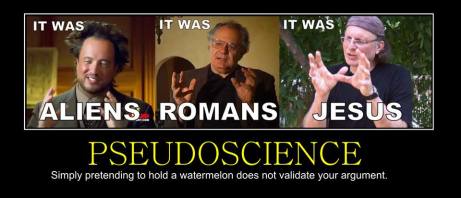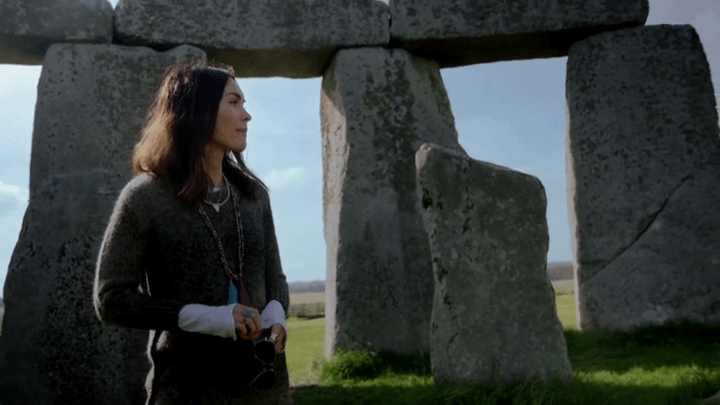
Fake, fraudulent, and fantastic topics in archaeology covered at Archaeology Review in 2018
Overall, I’d say that 2018 was a fairly slow year for pseudoarchaeology. There wasn’t really anything new being put out by the mystery-mongers and charlatans that take advantage of the average person’s curiosity and love of mystery. Instead, several old pseudoarchaeological ideas kept popping their ugly little heads back up begging to be whacked by logic and reason.
Below, I’ll list some of the topics in pseudoarchaeology I covered, linking to the original post, and giving a sentence or two to describe the post.
The Usual Suspects

Brien Foerster claimed to have DNA results for the skulls he and his “team” pretended to do science on. Foerster has long promoted the notion that the “elongated” skulls commonly found in Peru and Bolivia (as well as other places around the world) are something other than normal humans. They aren’t, of course. They’re just people who had their heads binded as infants to create the elongated effect. So Foerster and others took some samples and had aDNA tests run by one or more independent labs. The results? They proved that amateurs will consistently contaminate samples in the field and never believe it possible.
In the end: people of European descent mishandled and amateurishly pretended to be scientists as they reenacted the complex process of obtaining aDNA samples and their contamination showed that European DNA was present. Some would call this “cargo-cult archaeology.”
Andrew Collins created some small but ancient straw men to kick around. For some reason, Collins equated the find of a human jawbone just a few days walk from Africa as a vindication for the notion that there were modern humans of similar age in Europe. This all fits nicely to the early, racist notion that Europeans (i.e. white folk) are responsible for all that is good in the world and evidence for them must therefore be found in Europe. This is one of the ways we ended up with the Piltdown Man hoax.
Hugh Newman tried to connect Bolivian artifacts to assemblages thousands of miles and years away in the British Isles. The little Neolithic stone balls found over 6,000 miles away and 3,000 years are also accused of being “Platonic solids,” a mathematical term that describes a special type of polyhedron. Newman even suggested that the Bolivians themselves are Europeans by doing the “looks like” method of archaeology (this isn’t a real, scientific method by the way).
And, speaking of the “looks like” method of pseudoarchaeology, the Miami-Dade County Public Schools pulled a curriculum from their website after a few us wrote about its racist agenda. Miami-Dade isn’t necessarily a “usual suspect” among the pseudoarchaeology crowd, but school districts in general are. Especially when it comes to preaching Ivan Van Sertima’s well-debunked notion that the Olmecs are descendents from Africans because their sculptures have wide lips. This is racist and, luckily, someone at Miami-Dade agreed and took the curriculum down after I and two or three other sites pointed it out.
In the Popular Media
I also reviewed some popular media, namely the Butch Cassidy episode of Expedition Unknown and the four-episode series, Legends of the Lost with Megan Fox.

From the science-theater-makes-good-ratings department: Josh Gates can be seen in the Butch Cassidy episode of Expedition Unknown using a fractured humerus from Gallus gallus as a substitute for one of Butch Cassidy’s bones (one of his phalanges?). What is Gallus gallus you ask? A chicken. And a chicken humerus is part of its wing. Yes. Someone had Wing Stop for lunch and thought the bone would be easier to see on the television screens of consumers. I actually corresponded with the archaeologist they used to consult on the show and she confirmed that she pointed the chicken bone out to the production team and they still used it. For what it’s worth, there were some other, non-chicken bones that were potentially human in the pit.

And, more recently, I reviewed the four-part series (so far) Legends of the Lost with Megan Fox here, here, and here. A final review of the show that most recently aired is coming. Fox generally mixed good archaeology with batshit crazy archaeology and neo-New Age mumbo jumbo in what seems to be a lowly-rated television series. In one episode, you can see Tom Demere continue to defend the Cercutti Mastodon site as evidence for 130 kya humans in California. In spite of poorly presented evidence and a general lack of effort to even falsify his own work.
The Fun Stuff
There were also some general topics in pseudoarchaeology that I wrote on that many might find useful.
If you’re new to the genre as a skeptic, my post on What is Pseudoarchaeology might be helpful. I separate out some of the different sides to pseudoarchaeology such as nationalism, religious motivations, greed and status (mystery-mongering), and simply bad science.
Ley lines are also an extremely common fringe idea associated often with pseudoarchaeological ideas and even the paranormal. In this article, you can learn a little about the history of the notion behind ley lines, why they’re silly when you think about them scientifically, and perhaps even how the Megolithomania Facebook group got its name.

The last post this year I’d like to highlight was the article I wrote on New World Drugs and Old World Mummies in which I discuss the significance (or insignificance) of tobacco and cocaine traces found within the remains of Egyptian mummies that date to a period long before trans-Atlantic trade was thought to occur. If all goes well, a more detailed and in-depth version of this article will appear in Skeptical Inquirer in the near future (the editors there currently have it for consideration).
Leave a Reply
You must be logged in to post a comment.